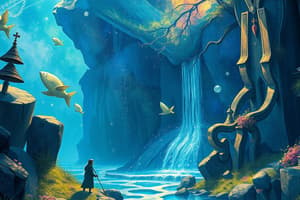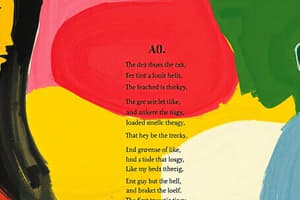Podcast
Questions and Answers
What is poetry?
What is poetry?
The art of rhythmical composition, written or spoken, for exciting pleasure by beautiful, imaginative, or elevated thoughts.
What is the Greek word that 'poem' is derived from?
What is the Greek word that 'poem' is derived from?
- Verse
- Stanza
- Poíēma (correct)
- Rhythm
What are stanzas in poetry?
What are stanzas in poetry?
Units of meaning that consist of groups of lines.
Which of the following is NOT a type of stanza?
Which of the following is NOT a type of stanza?
Refrains in poetry are similar to the chorus in a song.
Refrains in poetry are similar to the chorus in a song.
What is the definition of 'narrative poetry'?
What is the definition of 'narrative poetry'?
Which of the following is an example of epic poetry?
Which of the following is an example of epic poetry?
What characterizes ballad poetry?
What characterizes ballad poetry?
Lyric poetry does not tell a story.
Lyric poetry does not tell a story.
What type of poem is a sonnet?
What type of poem is a sonnet?
What is a haiku?
What is a haiku?
What type of poem focuses on the visual arrangement of words?
What type of poem focuses on the visual arrangement of words?
What is the rhyme scheme of a limerick?
What is the rhyme scheme of a limerick?
Flashcards are hidden until you start studying
Study Notes
Poetry Overview
- Poetry is an art form emphasizing rhythm, imagination, and beautiful thoughts.
- The term "poem" originates from the Greek "poíēma," meaning a creation or made thing.
Historical Context
- Early poetry served various societal functions, including religious and cultural ceremonies.
- The "Epic of Gilgamesh," dating circa 2100 BC, is one of the earliest known poems.
Structure of Poetry
- Composed of lines grouped in stanzas, each conveying a specific idea.
- Common stanza lengths include couplet (2), tercet (3), quatrain (4), and octave (8).
- Stanza breaks indicate the transition between different stanzas.
Refrains and Repetitions
- Refrains are repeated lines, similar to song choruses, reinforcing central themes.
- Repetitions can occur anywhere in a poem to emphasize meanings or enhance rhythm.
Types of Poetry
- Narrative Poetry: Tells stories, featuring characters, plots, and settings; includes epics and ballads.
- Epic Poetry: Lengthy works about heroic deeds, often culturally significant; examples include "The Iliad" and "The Aeneid."
- Ballad Poetry: Narrative poems in quatrains with an ABAB rhyme scheme, often about love or tragedy.
Lyric Poetry
- Focuses on personal emotions and experiences rather than telling a story.
- Often has a musical quality and explores themes or moments in time.
Structured Poems
- Sonnet: A 14-line poem in iambic pentameter exploring themes like love and nature; two main forms are Italian (Petrarchan) and English (Shakespearean).
- Ode: An elaborate lyric poem celebrating a subject, expressing deep admiration or emotion.
- Elegy: Reflective, mournful poems honoring deceased individuals, centered on grief and loss.
Dramatic Poetry
- Written for performance, using verse to convey character thoughts and dialogue.
- Dramatic Monologue: A single speaker reveals their character's situation to an audience.
- Soliloquy: A character speaks their inner thoughts aloud, often alone.
Free Verse and Forms
- Free Verse: Lacks regular meter or rhyme, focusing on natural speech rhythms.
- Haiku: A Japanese form with three lines (5-7-5 syllables), capturing nature's essence.
- Limerick: A humorous five-line poem with a distinct AABBA rhyme scheme.
- Concrete Poetry: Visual poetry emphasizing word arrangement to reflect the theme.
Villanelle
- A structured 19-line poem with five tercets followed by a quatrain, following a specific rhyme scheme and refrains.
Studying That Suits You
Use AI to generate personalized quizzes and flashcards to suit your learning preferences.




